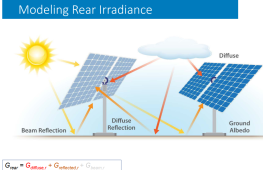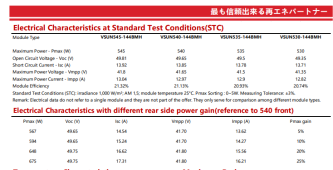Silly question - apologies if it is a repeat. For Bifacial panels where the spec sheets claim “up to 30% more efficiency” due to the Bifacial-ity. Would this be built into the advertised power rating, or would it all be potential upside? Thank you!!!
You are using an out of date browser. It may not display this or other websites correctly.
You should upgrade or use an alternative browser.
You should upgrade or use an alternative browser.
Bifacial power claims
- Thread starter Eerskie
- Start date
newbostonconst
Solar Enthusiast
- Joined
- Sep 24, 2019
- Messages
- 1,005
I often asked myself that when looking at the data sheet.....they seem to be deceiving us with the number but I don't know either....
12VoltInstalls
life passes by too quickly to not live in freedom
I can’t recall why I think this but I’m fairly certain they are rated for their frontal exposure; they have greater potential due to the cells being exposed to higher levels of light. (They can’t ever have actual exposure on both sides, now can theyWould this be built into the advertised power rating, or would it all be potential upside?
I’m unclear if bifacial makes a difference for many of us especially if mounted to a building or roof. Open installs like ground mounts or tilted on a roof, however, are where they’d shine. Pun intended ?
When I started solar with 200W panels at 45* mounted to an open frame on a flat roof I was in a place where I got filtered sun for 45 minutes or so first thing in the day, but no full sun until 12:30pm. I was amazed I would get some (minimal) charge with the sun on the backsides in that brief morning period. Amps basically went away again until sun exposure happened at 12:30pm when I would get 7-11A all afternoon.
And that is with commodity panels having no bifacial claims whatsoever. (I do realize some of that was atmospheric reflection on the front sides but obviously that happened all morning with essentially 0.1A or nothing. So I attributed it to the observable sun hitting the backside during that time period)
OzSolar
Whatever you did, that's what you planned.
Downside? They are heavier because they typically have a glass back sheet. So if you're putting them on your roof the structural engineering calculations should reflect that. That same roof would likely fail engineering with regular panels but's still worth mentioning.
Most manufacturers detail the power ratings in the cut sheet and typically it's on top of the advertised STC rating. What you should care about is not how they do on one cherry picked day at one sun angle, one time of day, etc but how much extra energy they produce over the course of the year.
Generally speaking you can't count on any gain on your shingled roof from what I've seen so for most people they aren't going to be worth paying anymore for.
Regarding additional power and energy. There's some papers out there that go into more detail than I can understand. Big words like Phi and albedo. What I think I took away from scanning them is that Bifacial gains generally only apply to ground mounts at a specific distance off the ground and with single axis tracking. Below is from an NREL paper. https://www.nrel.gov/docs/fy19osti/74090.pdf

Most manufacturers detail the power ratings in the cut sheet and typically it's on top of the advertised STC rating. What you should care about is not how they do on one cherry picked day at one sun angle, one time of day, etc but how much extra energy they produce over the course of the year.
Generally speaking you can't count on any gain on your shingled roof from what I've seen so for most people they aren't going to be worth paying anymore for.
Regarding additional power and energy. There's some papers out there that go into more detail than I can understand. Big words like Phi and albedo. What I think I took away from scanning them is that Bifacial gains generally only apply to ground mounts at a specific distance off the ground and with single axis tracking. Below is from an NREL paper. https://www.nrel.gov/docs/fy19osti/74090.pdf

Last edited:
Ozark Tinkering
Solar Addict
- Joined
- Dec 23, 2021
- Messages
- 1,109
I wonder how bi-facial panels react to heat reflected back up to the panel backside. Are they being used in the huge utility sized installations out in the California deserts? Will there be a flood of used bi-facial panels be hitting the market soon in the U.S.? Do they experience higher losses than mono-facial panels do in the summer heat?
svetz
Works in theory! Practice? That's something else
Given the need for elevation (the bottom edge is supposed to be at least 1m above the ground), it's probably less than other scenarios (e.g., metal roof) and probably gets a benefit of cooling from air movement underneath you wouldn't see from flat-mounted panels.I wonder how bi-facial panels react to heat reflected back up to the panel backside.
Ozark Tinkering
Solar Addict
- Joined
- Dec 23, 2021
- Messages
- 1,109
So it might be beneficial when installing the ground mount bi-facial system to put down a layer of white landscape rocks on top of a weed barrier, underneath the array?Given the need for elevation (the bottom edge is supposed to be at least 1m above the ground), it's probably less than other scenarios (e.g., metal roof) and probably gets a benefit of cooling from air movement underneath you wouldn't see from flat-mounted panels.
Ozark Tinkering
Solar Addict
- Joined
- Dec 23, 2021
- Messages
- 1,109
Maybe only allow white vehicles to park under my bi-facial solar carport. 
OzSolar
Whatever you did, that's what you planned.
DeLorean's would be the best. 1.21 gigawatts each all day every day.Maybe only allow white vehicles to park under my bi-facial solar carport.
Our bifacial panels perform excellent in winter when the ground is snow covered, which is when we need the power the most!So it might be beneficial when installing the ground mount bi-facial system to put down a layer of white landscape rocks on top of a weed barrier, underneath the array?
So true... mine are CS 390's that weigh about 63lbs. (But... they are about 3.5'x7')Downside? They are heavier because they typically have a glass back sheet.
I would agree with this 100% with my limited use so far. Mine is currently on a 9' pole optimized for angle. (That puts the lowest point about 6' off the ground.). What I think I took away from scanning them is that Bifacial gains generally only apply to ground mounts at a specific distance off the ground and with single axis tracking. Below is from an NREL paper. https://www.nrel.gov/docs/fy19osti/74090.pdf
We have played with this... the best I have seen so far is 420w on a clean panel, on a sunny & cold day with a perfectly snow covered ground... from a 390w BiF panel.So it might be beneficial when installing the ground mount bi-facial system to put down a layer of white landscape rocks on top of a weed barrier, underneath the array?
Agreed... providing its full sun.Our bifacial panels perform excellent in winter when the ground is snow covered, which is when we need the power the most!
I believe, this is spot on from my limited experiences. Will also tested this to a limited extent & also noted they are better in cooler climates.Given the need for elevation (the bottom edge is supposed to be at least 1m above the ground), it's probably less than other scenarios (e.g., metal roof) and probably gets a benefit of cooling from air movement underneath you wouldn't see from flat-mounted panels.
100% agreed & this is my plan long term as well.So it might be beneficial when installing the ground mount bi-facial system to put down a layer of white landscape rocks on top of a weed barrier, underneath the array?
*** Just corrected above number to 420W...NOT 450w. Sorry for the typo.
Last edited:
Even when it's not full sun they still out-perform our non-bifacial array.Agreed... providing its full sun.
I actually found white landscape fabric. Bit more expensive, but it seemed like the right thing to do, and was less visually offensive than expectedSo it might be beneficial when installing the ground mount bi-facial system to put down a layer of white landscape rocks on top of a weed barrier, underneath the array?
OK, I just talked with an installer and he says that the efficiency number on the spec sheet of a bifacial includes the backside. So a smaller non-bifacial panel of the same efficiency may be better if it doesn’t have much space behind it and space is limited. Bifacials are actually lower in efficiency on the front side than the advertised number? It seems to me I heard that the wattage and efficiency numbers were published only from the front side. The backside was extra.
Anyone have a definitive answer?
Anyone have a definitive answer?
OzSolar
Whatever you did, that's what you planned.
Here's a spec sheet for some modules that we used for the last 10 or so projects. Maybe this will answer your question.OK, I just talked with an installer and he says that the efficiency number on the spec sheet of a bifacial includes the backside. So a smaller non-bifacial panel of the same efficiency may be better if it doesn’t have much space behind it and space is limited. Bifacials are actually lower in efficiency on the front side than the advertised number? It seems to me I heard that the wattage and efficiency numbers were published only from the front side. The backside was extra.
Anyone have a definitive answer?

Yeah, all the spec sheets I've seen for bifacial clearly state what the power output is for just the front and it's efficiency and a separate section for different percent gains and effects it has on power output and other specs. This isn't like the Wild West of wind turbine power rating. There is a specific STC rating for a panel and that is for the front of the panel. Maybe some resellers are manipulating that. Just look at the spec sheet to know for sure.
HighDesertOffgrid
Solar Addict
- Joined
- Sep 15, 2022
- Messages
- 628
Some quartz rock ground cover below them might help during the other 3 seasons.Our bifacial panels perform excellent in winter when the ground is snow covered, which is when we need the power the most!
I dont need the power in the summer tbh, it's winter that is the problem :DSome quartz rock ground cover below them might help during the other 3 seasons.
I looked at the spec sheet, but it doesn’t break down where the efficiency numbers coming from.Yeah, all the spec sheets I've seen for bifacial clearly state what the power output is for just the front and it's efficiency and a separate section for different percent gains and effects it has on power output and other specs. This isn't like the Wild West of wind turbine power rating. There is a specific STC rating for a panel and that is for the front of the panel. Maybe some resellers are manipulating that. Just look at the spec sheet to know for sure.
Similar threads
- Replies
- 9
- Views
- 1K
- Replies
- 3
- Views
- 175


